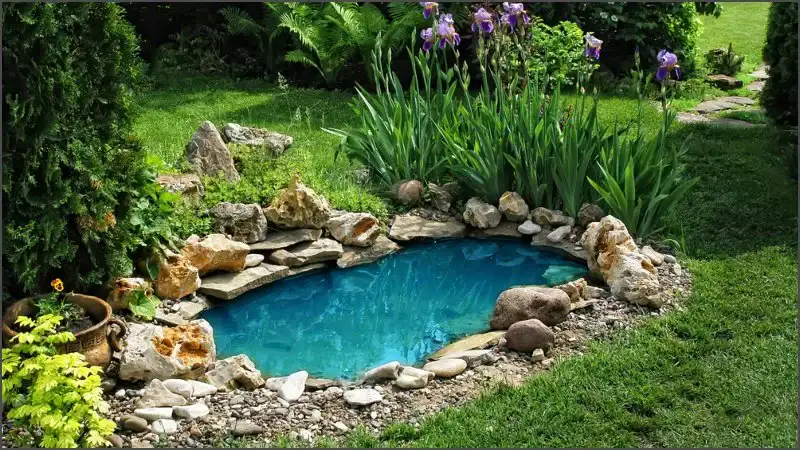Creating a natural wildlife pond in your garden is a wonderful way to promote biodiversity while adding beauty and tranquility to your outdoor space. Using natural wildlife pond edging ideas not only enhances the pond’s appearance but also makes it inviting for various species. Well-chosen, natural edges provide safe access to water for animals, offer shelter, and create mini-ecosystems that can attract a multitude of wildlife. In this comprehensive guide, we’ll explore the best edging materials and techniques to help you transform your pond into a thriving natural habitat.
Why Choose Natural Edging for Wildlife Ponds?
When designing a pond for wildlife, the edging is a critical component that affects both the ecosystem and the overall aesthetic. Natural edging materials, like rocks, logs, and native plants, support ecological balance and provide habitats for creatures such as frogs, birds, and insects. Unlike synthetic borders, natural wildlife pond edging ideas offer the following benefits:
- Encourage Biodiversity: Natural edges attract diverse species, from pollinators to small mammals.
- Reduce Erosion: Organic materials help stabilize soil and reduce erosion around the pond.
- Enhance Aesthetic Appeal: Natural edging materials blend seamlessly with the landscape, creating a harmonious and visually pleasing appearance.
Using Logs and Fallen Branches for a Rustic Edge
Logs and branches are excellent materials for a natural wildlife pond edging that mimics woodland environments. They offer shelter and hiding spots for animals, especially frogs, insects, and small mammals. Logs slowly decompose over time, adding nutrients to the soil and enhancing plant growth around the pond.
How to Incorporate Logs and Branches:
- Placement: Arrange logs around the pond edge, allowing some to extend into the water for amphibians and reptiles to bask on.
- Layering: Use layers of branches and logs to create depth and add texture to the pond’s edge.
- Natural Decay: Allow the logs to decay naturally, enriching the soil and supporting a variety of plant and animal life.
Stone and Rock Edging for a Timeless Look
Stones and rocks create a durable, erosion-resistant edge that provides natural perches for birds and basking spots for reptiles. Rock edging is particularly well-suited for ponds in sunny areas, as rocks retain heat, which can be beneficial for cold-blooded species.
Best Practices for Rock and Stone Edging:
- Vary Sizes: Use stones of different sizes to achieve a balanced, natural appearance.
- Incorporate Plants: Add small native plants between rocks to soften the appearance and attract insects.
- Create Hideaways: Stack rocks to form small crevices and cavities, offering shelter for wildlife.
Rock and stone borders make for practical natural wildlife pond edging ideas, giving the pond an organic feel while supporting diverse life forms.
Aquatic and Marginal Plants for a Lush Border
Native aquatic and marginal plants are essential for a natural wildlife pond edging that enhances the pond’s health. These plants prevent soil erosion, provide shelter, and attract pollinators such as bees and butterflies. Aquatic plants also play a role in filtering the water, creating a cleaner and more inviting pond for both wildlife and humans.
Popular Plant Choices for Pond Edges:
- Marsh Marigold: Known for its bright yellow flowers, it attracts pollinators and adds a splash of color.
- Water Mint: This fragrant plant is a favorite among bees and other pollinators.
- Cattails and Reeds: Great for stabilizing the soil and providing nesting materials for birds.
Adding native plants around the pond edge not only creates a visually appealing natural wildlife pond edging but also serves as a self-sustaining habitat for various species.
Using Gravel and Pebbles for Accessibility
For those looking for a low-maintenance yet natural-looking solution, gravel and pebbles are excellent choices. They allow rainwater to seep through easily, which helps reduce erosion. Additionally, gravel provides a safe surface for small creatures to navigate, making it ideal for a wildlife pond edge.
How to Use Gravel Effectively:
- Choose a Variety of Sizes: Mix different sizes and shapes to achieve a natural look.
- Combine with Soil: To create a seamless transition, mix gravel with soil and small plants.
- Wash the Gravel: Ensure the gravel is clean and free from chemicals that could harm pond life.
With gravel and pebbles, you can create a smooth, stable edge that complements other natural wildlife pond edging ideas while maintaining accessibility for smaller creatures.
Native Grass Strips and Turf for a Seamless Blend
Using turf or native grass strips around your pond creates a soft, seamless border that looks like an extension of your lawn. Native grasses are ideal for encouraging biodiversity, as they attract insects, which in turn attract birds and other animals. Grass strips create an inviting, approachable edge for wildlife.
Using Native Grass for Edging:
- Select Native Species: Native grasses are adapted to local conditions, making them easier to maintain.
- Keep Edges Trimmed: Regular trimming is essential to prevent overgrowth but avoid using pesticides.
- Create a Gentle Slope: Plant grass on a gentle slope towards the pond for easy access for animals.
This natural wildlife pond edging idea is both functional and attractive, blending the pond into the surrounding garden while creating a mini-habitat for local wildlife.
Building Shelters and Hideaways
Adding shelters and hideaways around the pond edge increases the pond’s appeal to wildlife. Small animals, especially amphibians, benefit from hidden spots where they can feel safe. Natural materials like rocks, logs, and plants can be arranged to provide these hideaways effectively.
Shelter Options:
- Rock Cavities: Stack rocks to form small crevices for animals to hide in.
- Brush Piles: Create piles of branches and leaves for additional cover and to attract insects.
- Grass Clumps: Dense grass clumps offer shelter and materials for nesting birds.
Integrating shelters into your natural wildlife pond edging ideas provides necessary cover for animals and contributes to a healthier ecosystem.
Creating a Sloping Edge for Accessibility
A gradual slope at the pond edge makes it easier for animals to enter and exit the water. Many creatures, particularly amphibians, prefer gentle slopes as they allow them to access the pond without risk. Sloped edges also reduce the risk of erosion, making them a sustainable choice for natural pond design.
Steps to Create a Sloped Edge:
- Excavate a Shallow Area: Dig a shallow edge that gradually deepens, ensuring a smooth transition.
- Stabilize with Gravel or Pebbles: Use gravel on the slope to keep the soil in place.
- Plant Vegetation: Choose native plants to stabilize the soil and create a natural look.
A sloped edge is an effective natural wildlife pond edging idea that serves both aesthetic and functional purposes, enhancing the pond’s appeal to wildlife.
Regular Maintenance for a Thriving Pond Edge
Maintaining a natural wildlife pond edge involves regular but simple tasks. By caring for the edging materials, you can preserve a balanced environment that remains inviting to wildlife year-round.
Maintenance Tips for Each Season:
- Spring: Trim dead foliage, refresh gravel or logs, and plant new native species if needed.
- Summer: Monitor water levels, add logs or stones for shade, and prune overgrown plants.
- Autumn: Clear fallen leaves, trim back overgrowth, and prepare the pond edge for winter.
- Winter: Leave some vegetation intact to provide shelter for wildlife during colder months.
Seasonal maintenance will ensure that your natural wildlife pond edging remains an ideal habitat for the local ecosystem, supporting biodiversity and maintaining a balanced environment.
Attracting Specific Wildlife to Your Pond
If you’re aiming to attract specific animals to your pond, making small adjustments to your pond edge can help. Each type of wildlife has particular needs, and thoughtful edge design can enhance your pond’s appeal to these creatures.
Edging Adjustments for Different Wildlife:
- Birds: Use flat stones for perches and shallow water areas for easy drinking.
- Amphibians: Incorporate logs and damp soil for hiding and moisture retention.
- Insects: Plant wildflowers around the pond edge to attract pollinators.
Implementing these small, targeted changes in your natural wildlife pond edging ideas can boost the diversity and health of your pond’s ecosystem.
Conclusion
Creating a wildlife-friendly pond edge is about more than aesthetics. By incorporating natural wildlife pond edging ideas like logs, stones, native plants, and gentle slopes, you’re supporting biodiversity and fostering a safe, nurturing environment for various species. A well-designed pond edge becomes a sanctuary, allowing you to observe and enjoy the richness of nature in your garden.


7r2fgs
jwiin7